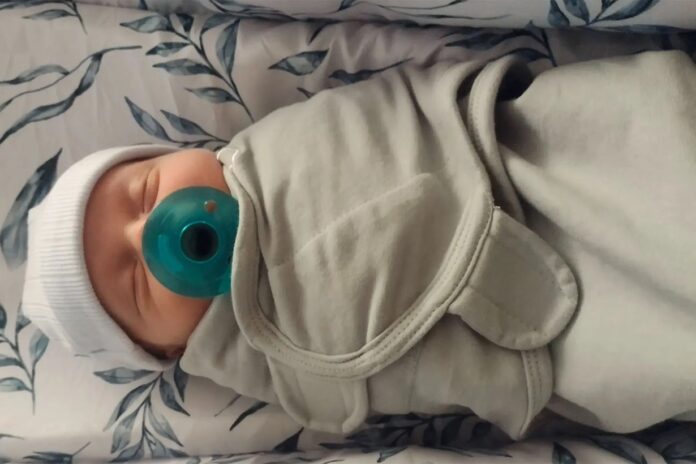- Record-Breaking Birth: Thaddeus Pierce was born from a 30-year-old frozen embryo, making him the world’s oldest known baby by embryo age.
- Emotional Journey: Donor Lydia Archerd preserved the embryos for decades before choosing adoption, fulfilling her long-held hope for their future.
- Public Reaction: The birth has sparked global discussions on embryo adoption, ethics, and the power of science to reshape modern family-building.
A tiny newborn in Ohio has made global headlines, not for his name or the color of his nursery, but for something far more extraordinary. Baby Thaddeus Daniel Pierce, born July 26, 2025, is believed to be the world’s oldest baby—because the embryo that created him was frozen back in May 1994.
For first-time parents Lindsey and Tim Pierce, both in their mid-30s and living in the quiet town of London, Ohio, this journey into parenthood wasn’t just unique—it was nearly unbelievable. Their miracle came through something most people don’t even know exists: embryo adoption.
A New Baby, A 30-Year Journey
When Lindsey held her newborn son for the first time, she could barely wrap her head around it. “We had a rough birth, but we are both doing well now,” she shared. “He’s so relaxed—just a really chill baby.”
What makes Thaddeus so remarkable is not just his calm nature. It’s the fact that the embryo that became him had been frozen in time for more than three decades. His embryo was created around the same time Friends first aired on television, before most people had even heard of the internet.
And here’s the real kicker: the baby has a biological sister—born in 1994—who is now 30 years old and has a 10-year-old child of her own. That makes baby Thaddeus both an uncle and a newborn at the same time.
Even Tim, now a proud dad, was just a toddler when the embryo that would become his son was placed into deep freeze. “We didn’t go into it thinking we’d break any kind of record,” Lindsey explained. “We just wanted a baby.”
But the record came anyway.
A Mother’s Long-Lost Dream
The embryo was originally created by Lydia Archerd, now 62, during her own struggle to conceive in the early 1990s. Lydia and her husband tried IVF, a relatively new technology at the time, and created four embryos. One led to the birth of her daughter in 1994. The other three were frozen.
“I always wanted another baby desperately,” Lydia recalled. She never gave up hope. “I called them my three little hopes.”
Life didn’t follow the path Lydia imagined. After her divorce and unsuccessful attempts to conceive again, she reached menopause without expanding her family. But she still paid \$1,000 a year to keep those embryos frozen—for over three decades.
Eventually, she made the emotional decision to donate the embryos, choosing embryo adoption through Nightlight Christian Adoptions, a program that allows both donors and adoptive families to meet—something that made the process feel more personal and meaningful for Lydia.
“It was the right thing to do,” she said, reflecting on the decision that would eventually lead to Thaddeus’s birth.
When the Past Meets the Present
What followed was a powerful moment of reconnection—across time and biology. After Thaddeus was born, Lindsey sent Lydia pictures. Lydia was stunned.
“The first thing I noticed was how much he looks like my daughter when she was a baby,” Lydia said. “I pulled out my baby book and compared the photos. There’s no doubt—they are siblings.”
She hopes to meet Thaddeus in person soon. In her heart, she believes her long-frozen embryos found the right home.
A Record-Breaking Birth That’s Stirring Emotions
The news has stirred strong emotions across social media and parenting communities. Some people are amazed by the science, calling the birth “a miracle of modern medicine.” Others are grappling with the deeper questions it raises: What does it mean to give birth to someone who was conceived in another century? How will the child understand his origins? What are the ethical boundaries?
The Pierces say those questions don’t shake them. For them, Thaddeus is simply their beloved son. “We were floored to even learn that embryo adoption was an option,” Lindsey said. “We had no idea embryos could be frozen that long ago, let alone survive.”
Critics of embryo freezing and long-term storage, however, have renewed concerns about how such embryos are handled, who decides their future, and what responsibilities both donors and adopters carry. Some argue the process needs more oversight. Others say it’s a blessing that gives life a second chance.
One thing is certain: the story has sparked global conversations about science, ethics, and the emotional complexity of reproduction.
A Future Filled with Questions—and Hope
While baby Thaddeus naps peacefully in his crib, unaware of the headlines he’s already made, his birth is changing the way many people think about family, science, and time.




